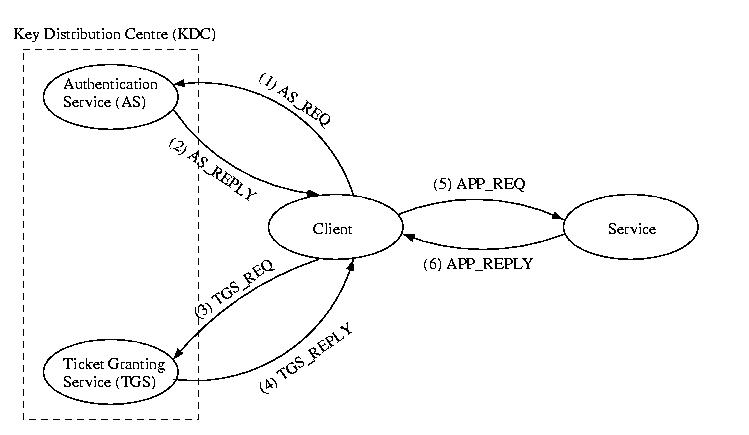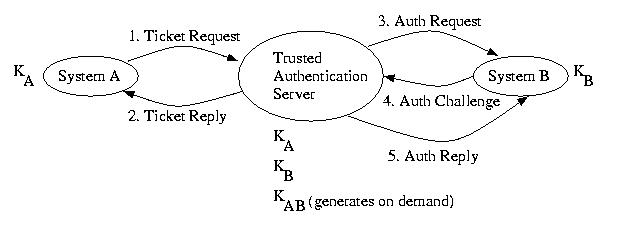Many of you may be somewhat familiar with the Kerberos Authentication
used to access services on the CMU network. You use kerberos to
prove your identity to the services that you use, such as telnet, rlogin,
ftp, &c. It also provides you an assurance that the service is actually
the service that you expect.
This protocol is based on the Needham Schroder protocol discussed above.
It strengthens the original protocol by adding a nonce to the message
which communicates the ticket between the two regular systems (not
the system with all of the private secrets). This prevents a
replay attack. It also pays much more attention to time. Instead of
issuing what amounts to a permanent ticket, all tickets expire. It
is also possible to request a ticket that is not immediately valid,
making reservations possible. Whereas the Needham-Schroeder protocol
was designed for peer-to-peer mutual authentication, Kerberos
was designed for client-server mutual authentication.
The first step is to contact the Authentication Service (AS)
of the Key Distribution Centre (KDC) and obtain what
is called a Ticket-Granting Ticket. In general a ticket
is a temporary device that allows a specific user access to a specific
service over a specific period of time. The ticket-granting ticket is
a special ticket that will allow the client to access the Ticket
Granting Service (TGS). The TGS in turn issues tickets valid
for specific services on specifc servers, e.x. ftp, telnet, &c.
Each user or service, known as a principle, has a secret, such as a
DES encrypted password. The secrets of all principles are known to
the AS. The secrets of all services are known to the TGS.

(1) AS_REQUEST
The first step in accessing a service that requires Kerberos
authentication is to obtain a ticket-granting ticket. To do this,
the client sends a plain-text message to the AS:
<client id, KDC id, requested ticket expiration, nonce1>
(2) AS_REPLY
The AS then creates a new secret, Kc,TGS to be shared
between the client and the TGS. It then encrypts this secret along with
the nonce using the user's private key, Kc. This is
then sent along a ticket for use by the client at the TSC,
ticketc, tgs. This ticket is encrypted using the TGS's
private key, KTGS. The AS can encrpyt these messages
using these private secrets, because it knows all of the secrets.
<{Kc, none1}Kc,TGS,
{ticketc,tgs}KTGS>
Once the client has the reply, it can decrpyt the first part of the
message and inspect the nonce. This nonce makes it a little more difficult
for a replay attack to occur, but in this capacity it is weak, since it
is sent in plain-text the first time.
The client also knows the shared secret that will be used to de/crpyt
messages exchanged with the TGS. It has ticket to prevent to the TGS.
This ticket was encrpyted b the AS using the TGS's private key --
the client can neither read it, nor alter it -- just present it.
The tickets contain the following information:
ticketx,y = {x, y, beginning valid time, expiration time,
Kx,y}
The ticket granting ticket is normally valid for about 8 hours.
(3) TGS_REQUEST
The TGS request asks the TGS for a ticket to communicate with a
a particular service.
<{authc}Kc, TGS,
{ticketc, TGS}KTGS,
service, nonce2>
The TGS will be able to decrypt both the ticket using its private key
and will know that it has not been forged, since only it and the AS
know its private secret.
{authc} is an authenticator. It just contians the
name of the sender and a timestamp. It is this timestamp that can
cause the "Time Out Of Bounds" errors while trying to get a
ticket granting ticket. The authenticator is only valid within a 5 minute
window of the timestamp...+/- 2.5 minutes. Again, thsi is a guard
against a replay attack.
(4) TS_REPLY
The reply to the client will contain the requested ticket --
this time encrypted with the service's private secret, to prevent
forgery by clients. As before, the ticket contains
Kc,service.
Another component of the message has two fields: Kc,service
and the nonce that was used for the request. This component is
encrypted using Kc, TGS. The client decrpyts it, verifies
the nonce, and learns the secret that it will use to communicate with
the service.
<{Kc,service, nonce2}Kc,
TGS, {ticketc, service}Kservice
>
(5) APP_REQ
Much as before, the application presents the encrypted ticket to the service, as well as a request and a nonce.
<{authc}Kc,service,
{ticketc, service}Kservice,
request, nonce3>
(6) APP_REPLY
As well as the reply to the request, the service sends back the nonce
that it received with the request, encrpted using the shared secret.
This assures the client that the request was answered by the
appropriate service, not an imposter.
<{nonce3}Kc,service, response>

